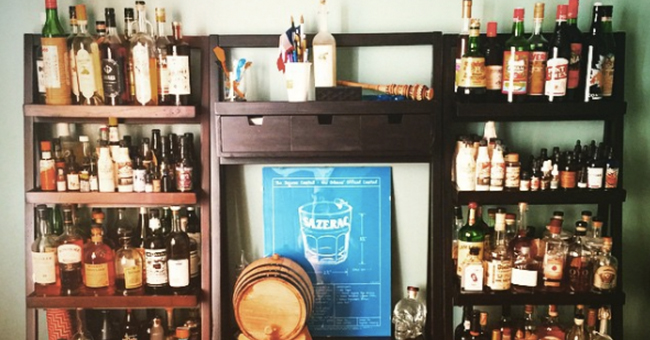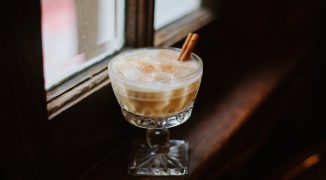When you work in bars all day (or night), it might seem counterintuitive to want to come home to one, but for Jason Coleman, brand ambassador for Sazerac Rye Whiskey and Buffalo Trace Bourbon, a home bar is the ultimate in relaxation. “it is really nice to come home and have a drink without my shoes on,” he says.
Coleman has been in the industry, beginning as a bartender, for ten years. In the past six, he’s gone from a limited selection in the corner of the guest bedroom, to a 300-bottle collection in a bar he’s built out in his New Orleans home, complete with finds from junk shops and movie set sales. “Six years ago I was going to the grocery store and getting a handle of bourbon so that I could have a bourbon on the rocks after I got off work.,” says Coleman. He shared some of the bar building tips and tricks he’s learned along the way.
Keep It Simple
Though it might be tempting to become a collector, Coleman suggests buying the ingredients for one or two cocktails that you really love, to start. “I guess this is how my bar started, we would have a party and I would look up maybe two or three cocktails and I would get the ingredients to make those three cocktails. You’re going to go through your liqueurs a little slower than your spirits, so then next time I have a party I would pick another two cocktails that I could use with some of the stuff I had, but maybe buy one more bottle. So you’re really not buying 15 bottles to get your complete bar stocked. Let’s face it, I don’t know many people that can go out and get 10 bottles and then the next week do the same thing.”
The simplicity extends to equipment as well. “I haven’t gotten anything to use for a bar in any of my apartments that was made to be a bar. I think it’s more fun when you find something that’s a little older or maybe beat up or it used to be something else and it’s got three shelves on it and that’s what you use,” says Coleman. “You can find plenty of carts with wheels on them and I think that’s the best because you can scoot it out into the living room, or wherever you are, you can have it pretty close, by the sink, or wherever you need it.”
Coleman goes to thrift and junk stores, and estate sales to find interesting glassware for home use. “For me at home, I’m not really looking for the highest quality, industrial everyday use stuff that is necessary for a bar. You’re not pumping out a hundred drinks,” says Coleman. At home, he often ignores glassware suggestions. “Honestly, the majority of drinks that I make at home are going to be in an Old Fashioned glass, even if it calls for something else. If I walk around my house with a coupe, I’m going to spill something.”
“You really don’t need a 30 dollar bar spoon or a copper jigger,” says Coleman. “The good thing about a jigger is, if it’s right, an ounce is an ounce no matter if it’s plastic, if it’s stainless steel, or if it’s platinum. If you’re making drinks at home, a measuring cup will be fine.”
Work Your Network
“As my friends and I have moved around, we kind of have our version of a housewarming party. Everyone brings a bottle that they like, we all get to drink, and all the bottles stay at the person’s house,” says Coleman. “A lot of my friends would have a party to drink all of their stuff, when they move, because they didn’t want to load up boxes with a bunch of quarter-full or half-full bottles and lug them all over town. So you’d be moving into that new spot and you would be bare bones or you would have maybe that half a case or case of liquor that you really don’t want to open for an everyday, it’s more of a celebration sip. So it was kind of a way of helping everybody move into their new spots.” These parties also provided a fun way to learn more about friends and their liquor preferences. “It is a funny way of seeing what people will bring to that. It’s pretty telling what they like or what they think you like. It’s a good way to learn something about somebody.”
Coleman belongs to a whiskey group in New Orleans, where they trade luxurious 3-ounce samples based on a theme, but he and his friends often do something similar, but less formal. Trading three ounces at a time offers a good way to try something you’re not sure you want to invest in, but also keeps your bar uncluttered. Trading duplicate bottles is another way to add variety your collection.
Brand sponsored events are always a popular way to build your bar, but Coleman cautions against getting caught up in the free samples. “I don’t want to bring a bottle home just because it was free, which sounds completely spoiled when I say it out loud. But are you going to have it just to have it? That’s a little more doable when you’re getting started, but once you start to get quite a few bottles that you really do enjoy or you’re starting to fill up your shelf, you don’t need to bring home that free bottle that you really just will never drink.”
In some of the bars Coleman worked in, he had the option of adding to the wholesale order and reimbursing the bar. “I would pay the bar the cost of that bottle, but I’m getting that at wholesale price, so on an 80 dollar bottle you’re saving 20 bucks,” he says. “If you’re saving 10, 15, 20, bucks a bottle, you buy five bottles and you’ve saved enough to buy another bottle.”
For Coleman, just being in the industry helps with collecting liquor. “We have the advantage of being tasted on things. Even just having friends in the industry, we’re going to give each other a bottle for our birthday. I definitely think you’ve got that advantage of working side by side with brands and with specialists. There are some bottles that trickle their way down. Whatever industry you’re in, you’re probably going to have more of that than people who aren’t and a lot of it does find you in very low cost or free ways.”
In spite of his impressive collection, Coleman doesn’t think of himself as a collector. He and his fiancée simply love to entertain friends, both in and out of the industry. “I went through and I popped the seal on a lot of bottles and I said ‘all right, it’s open, now we gotta try it,’ because before I’d be almost afraid to open these bottles, and I really had no reason not to have friends over and enjoy them.”





